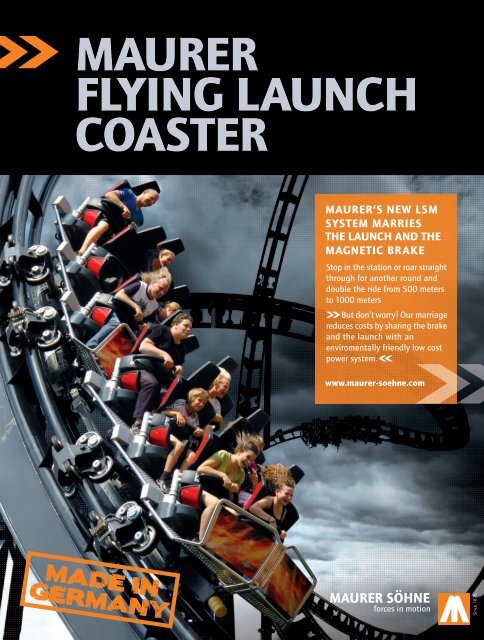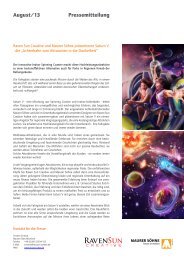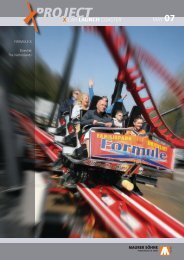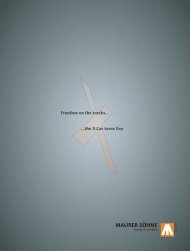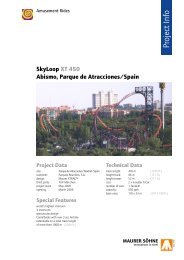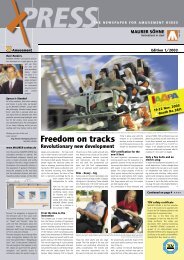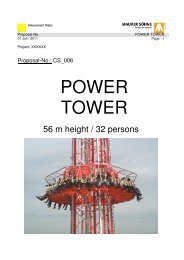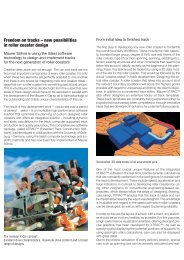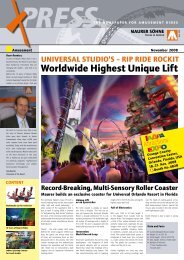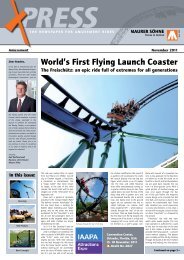MAURER FLYING LAUNCH COASTER - Maurer Rides
MAURER FLYING LAUNCH COASTER - Maurer Rides
MAURER FLYING LAUNCH COASTER - Maurer Rides
You also want an ePaper? Increase the reach of your titles
YUMPU automatically turns print PDFs into web optimized ePapers that Google loves.
<strong>MAURER</strong><br />
<strong>FLYING</strong> <strong>LAUNCH</strong><br />
<strong>COASTER</strong><br />
<strong>MAURER</strong>‘S NEW LSM<br />
SYSTEM MARRIES<br />
THE <strong>LAUNCH</strong> AND THE<br />
MAGNETIC BRAKE<br />
Stop in the station or roar straight<br />
through for another round and<br />
double the ride from 500 meters<br />
to 1000 meters<br />
But don‘t worry! Our marriage<br />
reduces costs by sharing the brake<br />
and the launch with an<br />
enviromentally friendly low cost<br />
power system.<br />
www.maurer-soehne.com
THE <strong>FLYING</strong><br />
<strong>LAUNCH</strong><br />
3 1<br />
IN<br />
The “Flying Launch” principle was<br />
first used at the Bayern-Park in<br />
Southern Bavaria: Including a spectacular<br />
start, gripping excitement<br />
up to the very last moment, different<br />
ride variations combined with<br />
the flying start while still maintaining<br />
a low energy cost, characterize<br />
this coaster. Additionally, it has<br />
other great innovations such as its<br />
illuminated wheels. But we won’t go<br />
into detail about that right now. The<br />
coaster innovators from <strong>Maurer</strong><br />
<strong>Rides</strong> Munich are already planning<br />
the next ride with a Flying Launch,<br />
for example, in the Ningbo Park in<br />
China. But what exactly does the<br />
Flying Launch mean? What added<br />
value does the principle really of-fer<br />
to amusement park operators?<br />
Let us first take a look at the classic motion<br />
sequence during a catapult launch, so<br />
that we can see the potential of the novel<br />
Flying Launch: The passengers get into<br />
the coaster at the station. The car is transported<br />
out of the station by electrical friction<br />
wheel drive units and accelerated up<br />
to the desired speed by a launch shot. At<br />
the end of the journey and just before the<br />
station, it shoots into the braking section<br />
and is slowed down being returned<br />
THE <strong>FLYING</strong> <strong>LAUNCH</strong> COMBINES THREE<br />
FUNCTIONS IN ONE IMAGINATIVE<br />
CONCEPT WITH ENORMOUS POTENTIAL<br />
FOR CREATIVITY AND SAVINGS<br />
to the station by drive wheels. To summarize,<br />
there are three motion elements that<br />
need to be taken into consideration in the<br />
planning, construction and operation of a<br />
roller coaster with regard to the station:<br />
Launch, brake and drive wheels.<br />
All in one: the Flying Launch principle<br />
The new Flying Launch handles all three<br />
elements simultaneously and integrates<br />
the launch, brake and drive wheels in one<br />
system. Once the passengers have gotten<br />
on board, the car is accelerated straight<br />
from a standstill position, and on its return<br />
there is no braking phase just before the<br />
station. Instead, the car shoots through<br />
the station from its residual energy and<br />
is braked electrically in the launch section<br />
by switching the electrical currents polarity<br />
thus changing the launch into a magnetic<br />
brake. The braking energy is stored<br />
temporarily and then reused for the next<br />
launch. The car comes to a standstill in the<br />
drive section and is quickly transported to<br />
the station. Then the classic “changing of<br />
the guests” takes place.<br />
This concept offers a whole series of<br />
development possibilities, from various<br />
points of view:<br />
• More fun from the very first second of<br />
the ride with the launch at the start.<br />
• More attractions can be included into<br />
the layouts, hence, they can be designed<br />
to be more exciting. This is too vague?<br />
What does this mean?<br />
• The “flying through the station” makes<br />
different ride variations possible by either<br />
stopping in the station or continuing the<br />
ride<br />
• Innovative technologies make a positive<br />
contribution to the ecological and<br />
economic balance by recycling some of<br />
the braking power into the next launch.<br />
More fun for the guests: from the<br />
very first to the very last second<br />
The most important target group in the<br />
park is, of course, the guests – and here<br />
the Flying Launch scores a number of<br />
“higher points” from the very first second.<br />
Since the launch stators are installed right<br />
at the station, there is no gradual starting<br />
up and gentle station exit. The roller<br />
coaster experience begins at once with a<br />
start like that of a Formula 1 race car, a<br />
bullet being fired or being beamed into<br />
another world.<br />
The riding experience can be savoured<br />
right up to the very last second<br />
because there is no braking before the<br />
station. A highlight at the end, a big<br />
finale that is like a last minute sprint<br />
FORCES IN MOTION<br />
Launch Coaster XL 2000<br />
Custom Designed / Bayern Park<br />
·Length: 483 m [1585 ft]<br />
·Height: 24 m [79 ft]<br />
·Run time: 55 sec<br />
·Max. speed: 80 km/h [50 mph]<br />
·Cars: 1 [2 x 6 seats]<br />
·Capacity: 600 people per hour<br />
•One single LSM launch at the ride’s start<br />
•Acceleration through same LSM (no braking)<br />
for a second round is possible<br />
•Regenerative braking energy is recovered<br />
for the next launch
to the end, the last big bang as in a fireworks<br />
display leaves the guests breathless<br />
when they arrive back at the station.<br />
And more than that: The guests are surprised<br />
as they pass through the station<br />
to what might be considered “late braking“<br />
by returning into the launch section.<br />
This “late braking“ lengthens the<br />
ride’s adventure. Even the entry into the<br />
station becomes an experience: by travelling<br />
backwards, something that is otherwise<br />
rare on roller coasters. The roller<br />
coaster ride remains interesting right up<br />
to the last moment instead of the leisurely<br />
cool-down phase that is part of<br />
more conventional roller coasters. More<br />
action and interaction is provided by<br />
the headchopper element when shooting<br />
through the station. A Flying Launch<br />
can be braked after the station, but need<br />
not be. Quite simply, what it means for<br />
the guests is this: There is a second round<br />
over the entire track without any stopping<br />
in between. This provides many<br />
times the riding excitement relative to the<br />
track length. It goes without saying that<br />
<strong>Maurer</strong> <strong>Rides</strong> provides the Flying Launch<br />
coaster with the multiple award-winning<br />
X-Seat, meaning: There are no interfering<br />
shoulder restraints to get in the way<br />
during inversions and negative g forces<br />
allowing for more freedom and fun.<br />
Space-saving layouts or more highlights<br />
on the same track<br />
The design advantages for roller coasters<br />
with Flying Launch can be seen at once. If<br />
there is no separate braking section, then<br />
there is more space for special elements –<br />
or to look at it from another point of view:<br />
Even if space is limited, it is still possible<br />
to design tracks with compact and interesting<br />
layouts: The “shooting through the<br />
station” that is possible at any time, doubles<br />
the track length as well: For example,<br />
1000 m of riding pleasure for a track<br />
length of 500 m – the ride experience<br />
was not possible up till now.<br />
On top of that, these short tracks can<br />
be designed with high speeds, since the<br />
excess energy does not need to be dissipated<br />
through external brakes but<br />
instead is recycled in the launch section.<br />
The same technical approach “recovering<br />
energy” can be applied to high track<br />
elements with a short track length: High<br />
track elements are attractive for the<br />
guests (view, sheer adrenaline) and serve<br />
as an advertisement for the park by being<br />
a landmark. This now means that even<br />
parks that are short of space can build<br />
such a highlight.<br />
The Flying Launch opens up the possibility<br />
of building attractive steep sections<br />
directly before or after the station: Thus,<br />
the launch can shoot into a camelback<br />
immediatlely or let the car “drop” into the<br />
station at the end. The camelback immediately<br />
after the start also means that the<br />
reverse-downwards entry into the station<br />
is even more exciting for the riders.<br />
Ecological and economic arguments<br />
Last but not least, the Flying Launch principle<br />
offers a whole series of economic<br />
and ecological advantages.<br />
The track is more cost-effective, since<br />
the transport drives in the station and<br />
the station brakes can be eliminated and<br />
hence the regular maintenance of the<br />
brake pads and friction wheel drive units<br />
that are subject to wear. In addition, the<br />
maintenance costs are reduced, since the<br />
remaining launch element also functions<br />
without any wear. The markedly lower<br />
amount of time and money required for<br />
maintenance also means less downtime,<br />
fewer staff is required, fewer materials are<br />
used and the system lasts longer.<br />
A technical benefit with multiple uses<br />
is the recovery of the braking energy<br />
through a generator. The energy that has<br />
been recovered can be stored temporarily<br />
and without any losses in the Supercaps<br />
and used again at the next start.<br />
This means: Only a low electrical capacity<br />
is required for the launch shot when it<br />
comes to the electrical connection to the<br />
local power plant. This greatly reduces<br />
the costs, because smaller transformers<br />
and distributor stations are perfectly adequate<br />
and because the lower current consumption<br />
peaks reduce electricity costs.<br />
The central data point for the profitability<br />
of the amusement park is the capacity.<br />
A roller coaster with Flying Launch allows<br />
high capacities of up to 1000 pph. Since<br />
the ride is intensely dynamic from the first<br />
to the last second, there are no longer any<br />
lengthy transport sections in and out of<br />
the station that reduces capacity.<br />
With a Flying Launch coaster, the section<br />
that is travelled is longer than with<br />
a classical layout because the launch area<br />
is travelled through twice (at the beginning<br />
and at the end). There are potentials<br />
for saving by designing a smaller launch<br />
and bringing the car up to the final speed<br />
by building up accelerations. A shorter<br />
launch provides more freedom in designing<br />
the layout and entails lower costs.<br />
And lastly, the safety aspect should not<br />
be forgotten either: The Flying Launch<br />
guarantees a high degree of safety due to<br />
the almost wear-free short-circuit braking<br />
in the unlikely event of a failed launch.<br />
FORCES IN MOTION<br />
conventional coasters<br />
Station<br />
Brake<br />
Green coaster<br />
Station<br />
Launch<br />
Brake manoeuvre<br />
Visit us:<br />
IAAPA Attractions Expo<br />
13 - 16 November 2012<br />
Orlando, Orange County Convention Center<br />
- Booth No. 4806<br />
LSM Launch & Brake<br />
ENERGY RECOVERY


